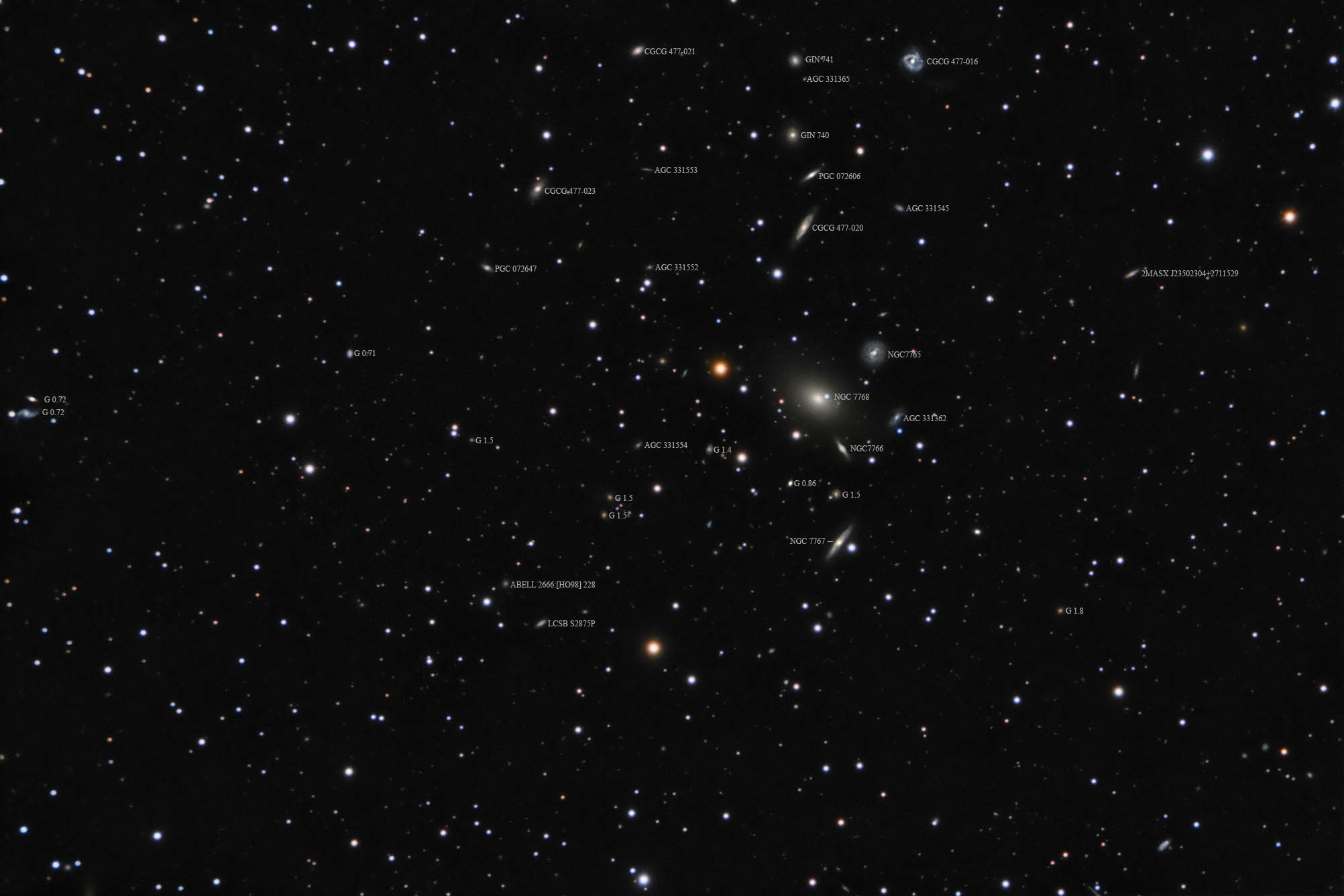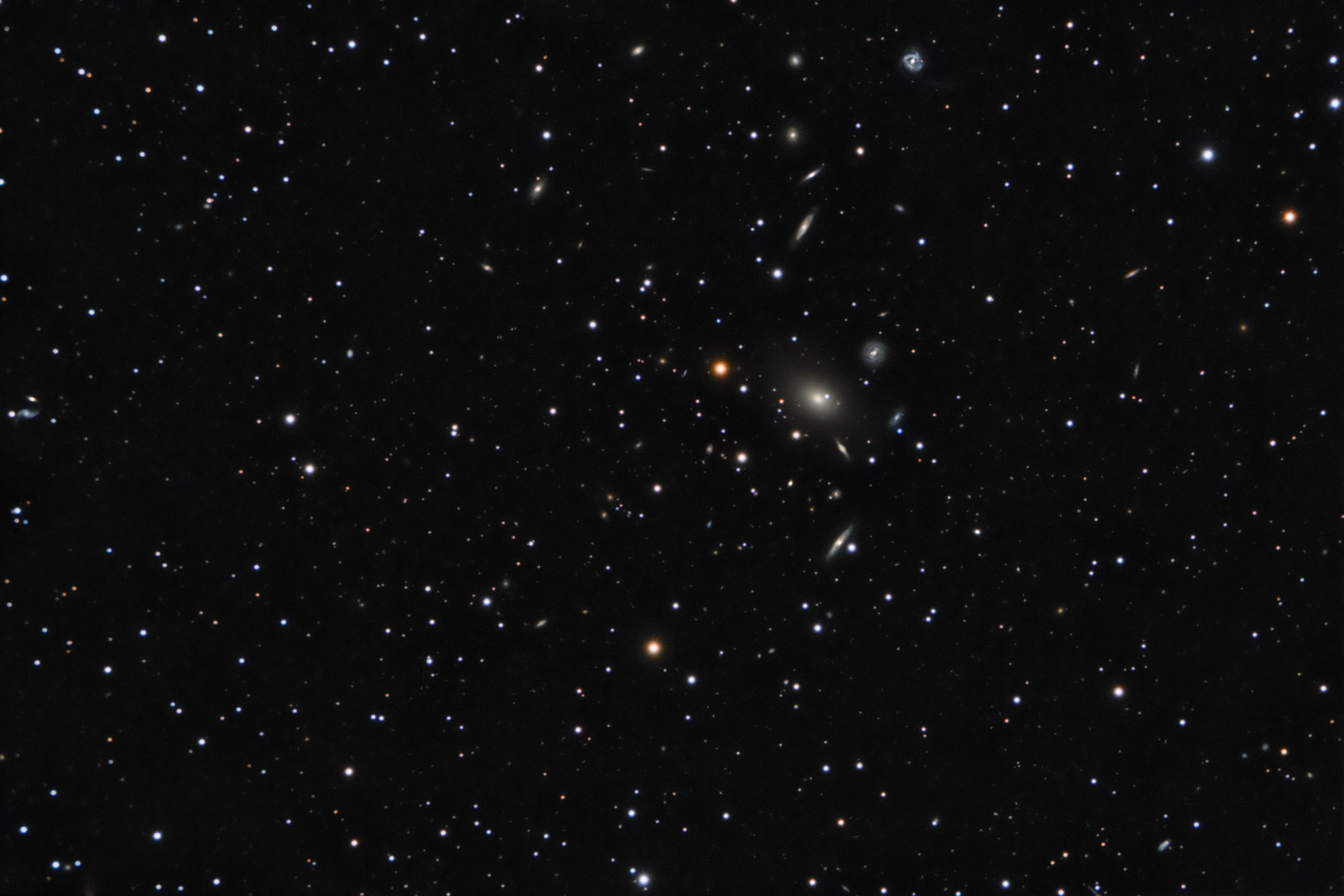| Description | Images |
Object name: NGC7765Designation(s): NGC7765, NGC7766, NGC7767, NGC7768, CGCG_477_016, ABELL2666, NGC 7768 is the cD elliptical galaxy that anchors the Abell 2666 cluster. It has far fewer globular clusters than would be expected for a galaxy of its size and location. The cluster is about 350 million light years distant and located in the northeast part of the Great Square of Pegasus. As Abell clusters go this is a small one. In the annotated image I've noted those that are likely true members of the cluster by showing their catalog name. As space was tight and galaxies have many different catalog entries I usually used the shortest to keep clutter down. It was discovered by John Herschel on September 5, 1828. Related Designation(s):2MASS J23504748+2717168, 2MASS J23505214+2709586, 2MASS J23505242+2709583, 2MASS J23505589+2707350, 2MASS J23505636+2705136, 2MASS J23505853+2708503, 2MASX J23504749+2717167, 2MASX J23505214+2709587, 2MASX J23505589+2707347, 2MASX J23505634+2705137, 2MASX J23505859+2708507, 2MASXi J2350474+271716, 2MASXi J2350521+270958, 2MASXi J2350558+270734, 2MASXi J2350563+270513, 2MASXi J2350585+270850, 2MFGC 17897, ABELL 2666, ABELL 2666:[BTM97] 1, ABELL 2666:[CAC2009] BCM, ABELL 2666:[CBW93] A, ABELL 2666:[H80c] 003, ABELL 2666:[H80c] 004, ABELL 2666:[H80c] 005, ABELL 2666:[H80c] 006, ABELL 2666:[H80c] 007, ABELL 2666:[HO98] 201, ABELL 2666:[HO98] 202, ABELL 2666:[HO98] 205, ABELL 2666:[HO98] 210, ABELL 2666:[L84] G1, ABELL 2666:[MS77] 01, ABELL 2666:[MS77] 02, ABELL 2666:[MS77] 03, ABELL 2666:[PL95] BCG, ABELL 2666:[WCB96] B, ABELL2666, AGC 330953, AGC 330954, AGC 331546, ALFALFA 2-466, CAN 084, CAN 084 NED01, CAN 084 NED02, CGCG 2348.2+2654, CGCG 2348.2+2701, CGCG 2348.3+2649, CGCG 2348.3+2651, CGCG 2348.4+2653, CGCG 477 016, CGCG 477-015, CGCG 477-016, CGCG 477-017, CGCG 477-018, CGCG 477-019, CID 84, GALEXASC J235047.45+271718.0 , GALEXASC J235052.16+270958.6 , GALEXASC J235055.89+270736.7 , GALEXASC J235056.38+270513.7 , GALEXMSC J235047.43+271717.3 , GALEXMSC J235052.16+270958.7 , GALEXMSC J235055.93+270735.2 , GALEXMSC J235056.35+270514.6 , GIN 738, GIN 739, HDCE 1256 NED001, HDCE 1256 NED002, HOLM 818A, HOLM 818B, HOLM 818C, HOLM 818D, IRAS F23482+2700, KUG 2348+270A, LDCE 1595 NED008, LDCE 1595 NED009, LT 36, MCG +04-56-014, MCG +04-56-015, MCG +04-56-016, MCG +04-56-017, MCG +04-56-018, NGC 7765, NGC 7766, NGC 7767, NGC 7768, NGC7765, NGC7766, NGC7767, NGC7768, NPM1G +26.0551, NSA 152757, NSA 152758, NSA 152759, NSA 152761, NSA 171229, NVSS J235047+271727, PGC 072596, PGC 072600, PGC 072601, PGC 072605, PGC 072611, RASSCALS SRGb 046, SCL 215 NED02, SDSS J235058.55+270850.4, UGC 12805, UGC 12806, USGC U858 NED05, USGC U858 NED06, USGC U858 NED07, UZC J235047.5+271716, UZC J235056.4+270513, UZC J235058.6+270849, WBL 724-001, WBL 724-002, WBL 724-003, WBL 724-004, WBL 724-005, ZwCl 2335.5+2449 NED02, [AO95] 2348+2700, [M98j] 265 NED02, [M98j] 265 NED03, [MO2001] J235047.5+271715.7, |

